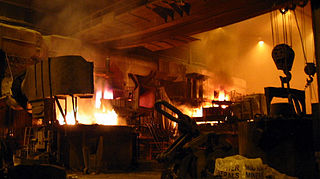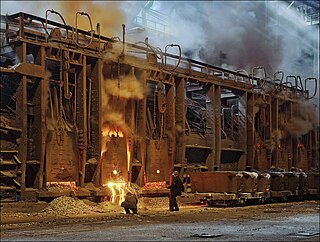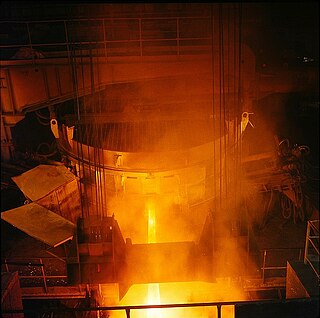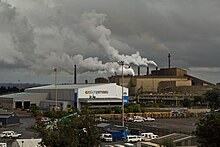
Steelmaking is the process of producing steel from iron ore and/or scrap. Steel has been made for millennia, and was commercialized on a massive scale in the 1850s and 1860s, using the Bessemer and Siemens-Martin processes.

Basic oxygen steelmaking, also known as Linz-Donawitz steelmaking or the oxygen converter process, is a method of primary steelmaking in which carbon-rich molten pig iron is made into steel. Blowing oxygen through molten pig iron lowers the carbon content of the alloy and changes it into low-carbon steel. The process is known as basic because fluxes of calcium oxide or dolomite, which are chemical bases, are added to promote the removal of impurities and protect the lining of the converter.

A steel mill or steelworks is an industrial plant for the manufacture of steel. It may be an integrated steel works carrying out all steps of steelmaking from smelting iron ore to rolled product, but may also be a plant where steel semi-finished casting products are made from molten pig iron or from scrap.

An open-hearth furnace or open hearth furnace is any of several kinds of industrial furnace in which excess carbon and other impurities are burnt out of pig iron to produce steel. Because steel is difficult to manufacture owing to its high melting point, normal fuels and furnaces were insufficient for mass production of steel, and the open-hearth type of furnace was one of several technologies developed in the nineteenth century to overcome this difficulty. Compared with the Bessemer process, which it displaced, its main advantages were that it did not expose the steel to excessive nitrogen, was easier to control, and permitted the melting and refining of large amounts of scrap iron and steel.

An electric arc furnace (EAF) is a furnace that heats material by means of an electric arc.
Ferroalloy refers to various alloys of iron with a high proportion of one or more other elements such as manganese (Mn), aluminium (Al), or silicon (Si). They are used in the production of steels and alloys. The alloys impart distinctive qualities to steel and cast iron or serve important functions during production and are, therefore, closely associated with the iron and steel industry, the leading consumer of ferroalloys. The leading producers of ferroalloys in 2014 were China, South Africa, India, Russia and Kazakhstan, which accounted for 84% of the world production. World production of ferroalloys was estimated as 52.8 million tonnes in 2015.

An ironworks or iron works is an industrial plant where iron is smelted and where heavy iron and steel products are made. The term is both singular and plural, i.e. the singular of ironworks is ironworks.
IISCO Steel Plant of Steel Authority of India Limited is an integrated steel plant located at Burnpur, a neighbourhood in Asansol city, in the Asansol subdivision of Paschim Bardhaman district, West Bengal, India.
The global steel industry has been going through major changes since 1970. China has emerged as a major producer and consumer, as has India to a lesser extent. Consolidation has been rapid in Europe. According to the 2019 International Energy Agency (IEA) report, the iron and steel industry directly contributed 2.6 Gt to global CO2 emissions and accounted for 7% of global energy demand. Singapore is the world's main trading hub for iron, with about 90% of the world's iron ore derivatives traded on their stock exchange.

Ironsand, also known as iron-sand or iron sand, is a type of sand with heavy concentrations of iron. It is typically dark grey or blackish in color.
Stewarts & Lloyds was a steel tube manufacturer with its headquarters in Glasgow at 41 Oswald Street. The company was created in 1903 by the amalgamation of two of the largest iron and steel makers in Britain: A. & J. Stewart & Menzies, Coatbridge, North Lanarkshire, Scotland; and Lloyd & Lloyd, Birmingham, England.

The tatara (鑪) is a traditional Japanese furnace used for smelting iron and steel. The word later also came to mean the entire building housing the furnace. The traditional steel in Japan comes from ironsand processed in a special way, called the tatara system.

Mining in New Zealand began when the Māori quarried rock such as argillite in times prior to European colonisation. Mining by Europeans began in the latter half of the 19th century.
The HIsarna ironmaking process is a direct reduced iron process for iron making in which iron ore is processed almost directly into liquid iron (pig iron). The process combines two process units, the Cyclone Converter Furnace (CCF) for ore melting and pre-reduction and a Smelting Reduction Vessel (SRV) where the final reduction stage to liquid iron takes place. The process does not require the manufacturing of iron ore agglomerates such as pellets and sinter, nor the production of coke, which are necessary for the blast furnace process. Without these steps, the HIsarna process is more energy-efficient and has a lower carbon footprint than traditional ironmaking processes. In 2018 Tata Steel announced it has demonstrated that more than 50% CO2 emission reduction is possible with HIsarna technology, without the need for carbon capture technology.
John Chambers was a British citizen who became a New Zealand businessman and ironsands entrepreneur.
In 2022, the U.S. was the third-largest producer of raw steel worldwide, after China and India, and ranked sixth in pig iron production. By November 2024, the industry produced over 74 million net tons annually.

The Onehunga Ironworks was a colonial-era iron smelting and rolling operation at Onehunga, on the Manukau Harbour,. It was at one time claimed to be the largest ironworks in the Southern Hemisphere. It is significant, both as the first large scale attempt to exploit New Zealand's iron-sand by direct reduction, and as a precursor of the modern steel industry of New Zealand.
Otaua is a rural settlement in the Waikato District and Waikato region of New Zealand's North Island. It is located south of Waiuku and west of Aka Aka, on the northern side of the Waikato River. The Otaua area includes the Waikato North Head on the northern side of the Waikato River mouth, opposite Port Waikato to the south.

A metallurgical furnace, often simply referred to as a furnace when the context is known, is an industrial furnace used to heat, melt, or otherwise process metals. Furnaces have been a central piece of equipment throughout the history of metallurgy; processing metals with heat is even its own engineering specialty known as pyrometallurgy.
Manufacturing in New Zealand contributed $23 billion (12%) of the country's gross domestic product and directly employed 241,000 people in 2017, while manufactured goods made up 52% of the country's exports by value. The food and beverage subsector alone contributed 32% of manufacturing's GDP and 71% of exports.















